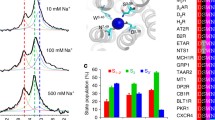Summary
The modulation of radioligand binding at R i adenosine receptors of rat fat cells by guanine nucleotides and cations was investigated. Guanine nucleotides (in the order of potency: GTP=GDP>Gpp(NH)p>5′-GMP) decreased the binding of the R i receptor agonist (−)N6-phenylisopropyl[3H]adenosine ([3H]PIA), but did not affect binding of the antagonist 1,3-diethyl-8[3H]phenylxanthine ([3H]DPX). Saturation of [3H]PIA binding revealed that GTP (100 μmol/l) converts the high affinity form of the R i receptor into a low affinity form. This effect was confirmed in kinetic experiments. GTP decreased the potency of agonists in competing for [3H]DPX binding, as shown by a 50-fold shift of the K i-value for (−)PIA, whereas antagonist-induced inhibition of binding remained unchanged. The divalent cations Mg2+ and Ca2+ produced a slight increase in [3H]PIA binding but did not affect [3H]DPX binding. Mn2+ markedly decreased both agonist and antagonist binding at R i adenosine receptors. Divalent cations reversed the guanine nucleotide-induced decrease of affinity of the R i receptor. Na+ did not significantly affect agonist or antagonist binding but abolished the stimulatory effect of Mg2+ on agonist binding in the presence of GTP. Our data indicate that guanine nucleotides convert the R i adenosine receptor of rat fat cells from a high to a low agonist affinity state and that the modulation of radioligand binding by mono-and divalent cations differs from that of R i receptors of other tissues.
Similar content being viewed by others
References
Aktories K, Schultz G, Jakobs KH (1981) Na+ amplifies adenosine receptor-mediated inhibition of adipocyte adenylate cyclase. Eur J Pharmacol 71:157–160
Blume AJ (1978) Interaction of ligands with the opiate receptor of brain membranes: Regulation by ions and nucleotides. Proc Natl Acad Sci USA 75:1713–1717
Bruns RF, Daly JW, Snyder SH (1980) Adenosine receptors in brain membranes: Binding of N6-cyclohexyl[3H]adenosine and 1,3-diethyl-8[3H]phenylxanthine. Proc Natl Acad Sci USA 77: 5547–5551
Chen RF (1967) Removal of fatty acids from serum albumin by charcoal treatment. J Biol Chem 242:173–181
Cooper DMF (1982) Bimodal regulation of adenylate cyclase. FEBS Lett 138:157–163
Daly JW (1982) Adenosine receptors: Targets for future drugs. J Med Chem 25:197–207
De Lean A, Hancock AA, Lefkowitz RJ (1982) Validation and statistical analysis of a computer modeling method for quantitative analysis of radioligand binding data for mixtures of pharmacological receptor subtypes. Mol Pharmacol 21:5–16
Gavish M, Goodman RR, Snyder SH (1982) Solubilized adenosine receptors in the brain: Regulation by guanine nucleotides. Science 215:1633–1635
Goodman RR, Cooper MJ, Gavish M, Snyder SH (1982) Guanine nucleotide and cation regulation of the binding of [3H]cyclohexyladenosine and [3H]diethylphenylxanthine to adenosine A1 receptors in brain membranes. Mol Pharmacol 21:329–335
Grandt R, Aktories K, Jakobs KH (1982) Guanine nucleotides and monovalent cations increase agonist affinity of prostaglandin E2 receptors in hamster adipocytes. Mol Pharmacol 22: 320–326
Greenberg DA, U'Prichard DC, Sheehan PP, Snyder SH (1978) α-Noradrenergic receptors in the brain: Differential effects of sodium on binding of [3H]agonist and [3H]antagonists. Brain Res 140:378–384
Hüttemann E, Ukena D, Lenschow V, Schwabe U (1984) R a Adenosine receptors in human platelets: Characterization by 5′-N-ethylcarboxamido[3H]adenosine binding in relation to adenylate cyclase activity. Naunyn-Schmiedeberg's Arch Pharmacol 325:226–233
Lenschow V, Schwabe U (1982) Effects of guanine nucleotides on adenosine receptors in rat brain. Naunyn-Schmiedeberg's Arch Pharmacol 319:R6
Limbird LE (1981) Activation and attenuation of adenylate cyclase. Biochem J 195:1–13
Londos D, Cooper DMF, Schlegel W, Rodbell M (1978) Adenosine analogs inhibit adipocyte adenylate cyclase by a GTP-dependent process: Basis for actions of adenosine and methylxanthines on cyclic AMP production and lipolysis. Proc Natl Acad Sci USA 75:5362–5366
Londos C, Cooper DMF, Wolff J (1980) Subclasses of external adenosine receptors. Proc Natl Acad Sci USA 77:2551–2554
Londos C, Wolff J, Cooper DMF (1981) Adenosine as a regulator of adenylate cyclase. In: Burnstock G (ed) Purinergic receptors. Chapman and Hall, London New York, pp 289–323
Lowry OH, Rosebrough NJ, Farr AL, Randall RJ (1951) Protein measurement with the Folin phenol reagent. J Biol Chem 193:265–275
McKeel DW, Jarett L (1970) Preparation and characterization of a plasma membrane fraction from isolated fat cells. J Cell Biol 44:417–432
Pert CB, Snyder SH (1974) Opiate receptor binding of agonists and antagonists affected differentially by sodium. Mol Pharmacol 10:868–879
Rodbell M (1964) Metabolism of isolated fat cells. I. Effects of hormones on glucose metabolism and lipolysis. J Biol Chem 239:375–380
Rodbell M (1980) The role of hormone receptors and GTP-regulatory proteins in membrane transduction. Nature 284:17–22
Schwabe U (1983) General aspects of binding of ligands to adenosine receptors. In: Berne R, Rall TW, Rubio R (eds) Regulatory function of adenosine. Marinus Nijhoff Publishers, The Hague Boston London, pp 77–96
Trost T, Schwabe U (1981) Adenosine receptors in fat cells. Identification by (−)-N6-[3H]phenylisopropyladenosine binding. Mol Pharmacol 19:228–235
Yeung S-MH, Green RD (1983) Agonist and antagonist affinities for inhibitory adenosine receptors are reciprocally affected by 5′-guanylylimidodiphosphate or N-ethylmaleimide. J Biol Chem 258:2334–2339
Author information
Authors and Affiliations
Rights and permissions
About this article
Cite this article
Ukena, D., Poeschla, E. & Schwabe, U. Guanine nucleotide and cation regulation of radioligand binding to R i adenosine receptors of rat fat cells. Naunyn-Schmiedeberg's Arch. Pharmacol. 326, 241–247 (1984). https://doi.org/10.1007/BF00505325
Received:
Accepted:
Issue Date:
DOI: https://doi.org/10.1007/BF00505325




